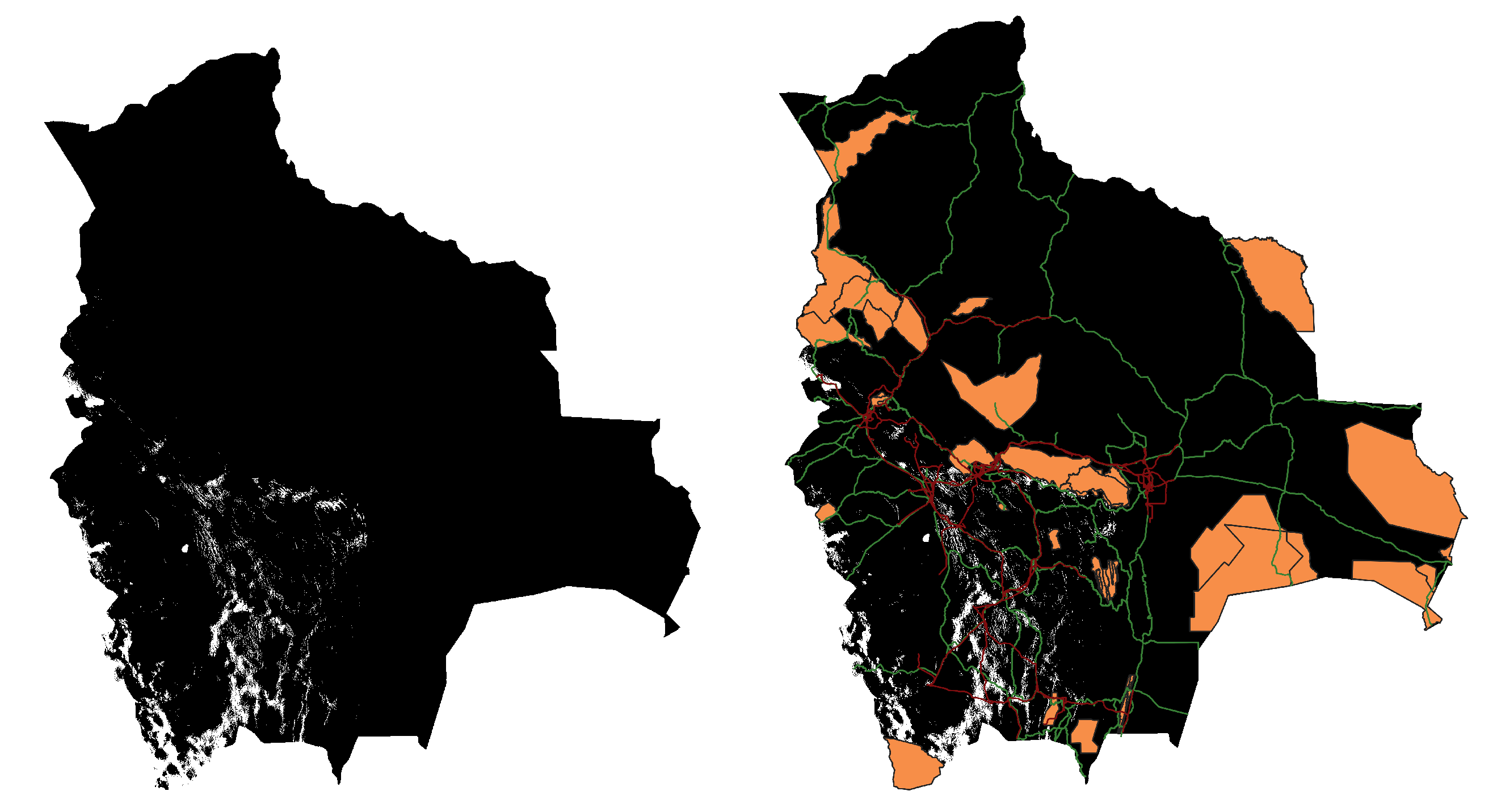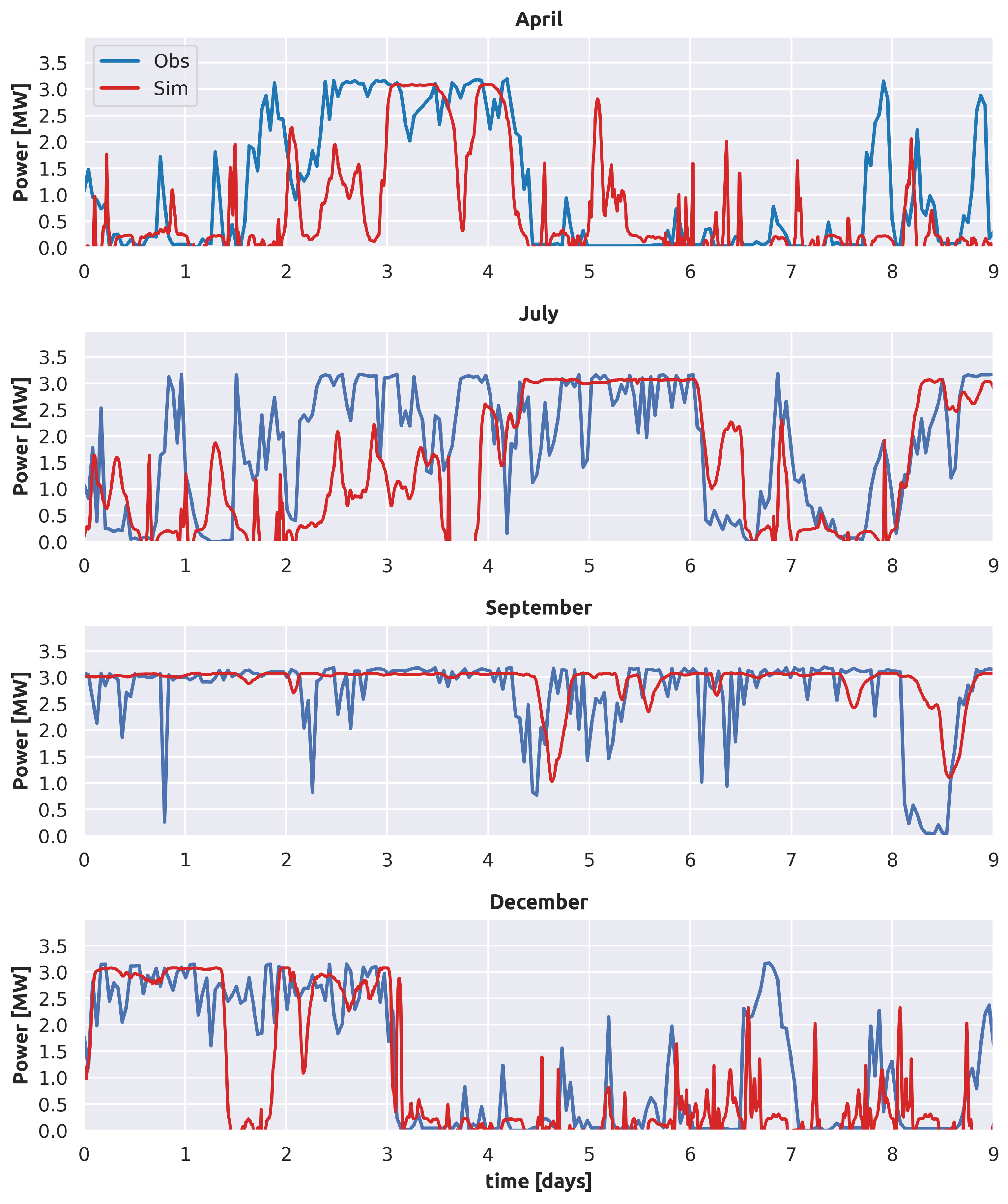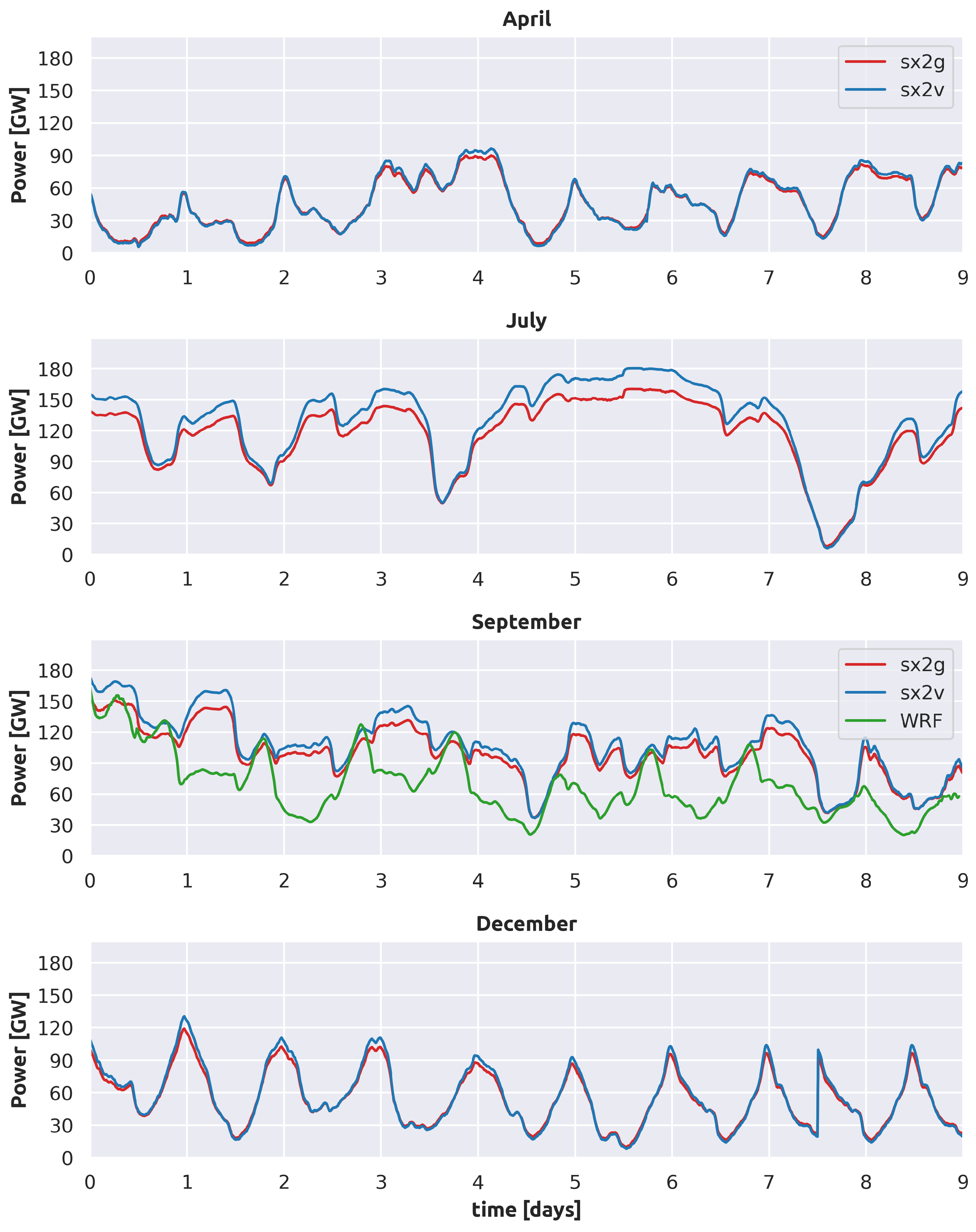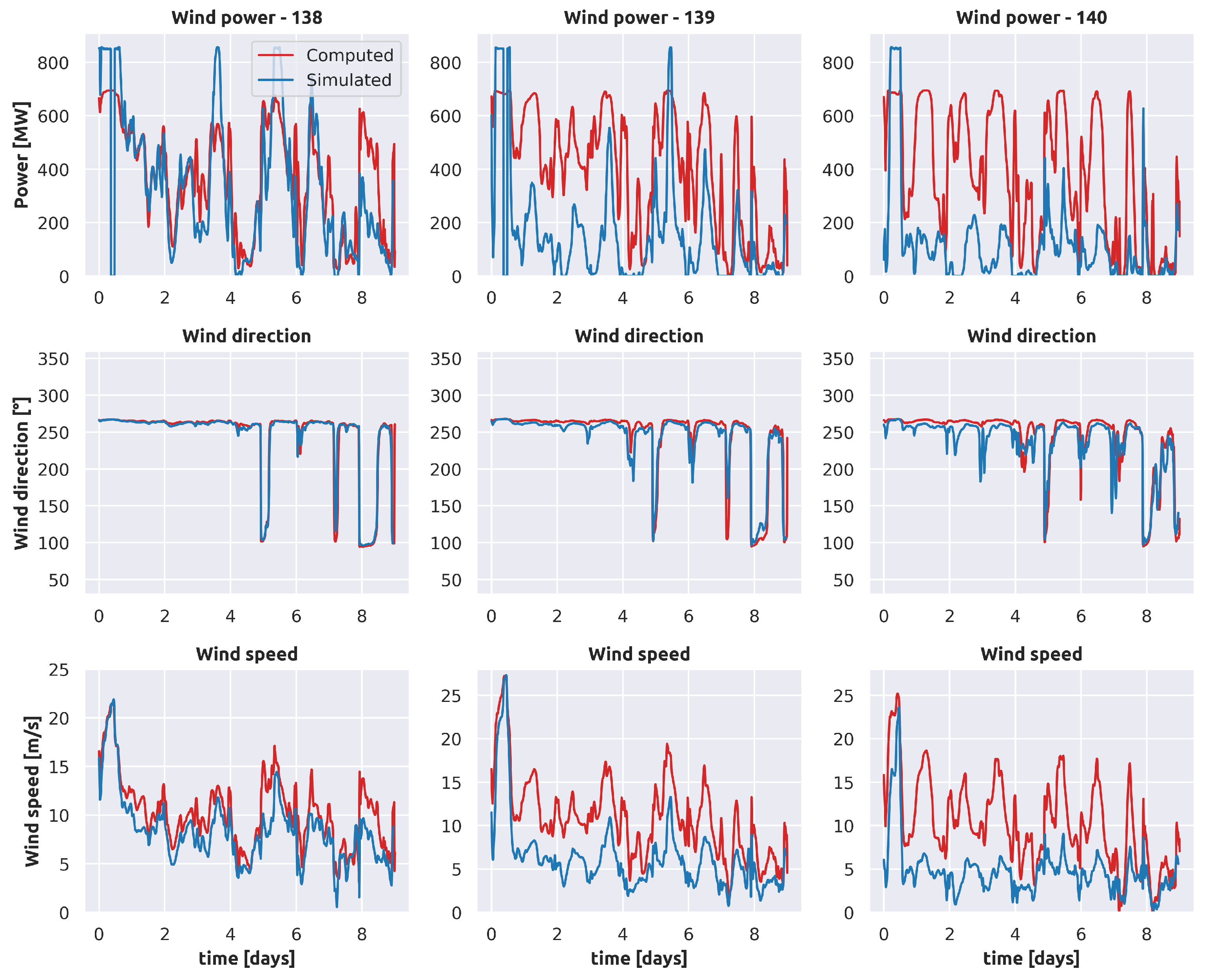Wind Power Potential in Highlands of the Bolivian Andes: A Numerical Approach
Abstract
:1. Introduction
2. Methodology
2.1. Description of the Site and Data
2.2. Validation and Grid Sensitivity Analysis in WRF Model
2.3. Wind Power Potential in the Bolivian Andes by WRF Model
2.4. Global Wind Atlas Evaluation in the Bolivian Andes
3. The Wind Power Potential in the Bolivian Andes by GWA
4. Grid Sensitivity and Validation in WRF for Wind Farms
5. The Wind Power Potential in the Bolivian Andes by WRF Model
6. The Wind Power Dynamics in the Bolivian Andes
7. Conclusions
Supplementary Materials
Author Contributions
Funding
Institutional Review Board Statement
Informed Consent Statement
Data Availability Statement
Acknowledgments
Conflicts of Interest
References
- Al-Yahyai, S.; Charabi, Y.; Gastli, A. Review of the use of Numerical Weather Prediction (NWP) Models for wind energy assessment. Renew. Sustain. Energy Rev. 2010, 14, 3192–3198. [Google Scholar] [CrossRef]
- IRENA. Renewable Capacity Statistics 2021; International Renewable Energy Agency (IRENA): Abu Dhabi, United Arab Emirates, 2021; p. 64. [Google Scholar]
- Gonzalez-Salazar, M.; Poganietz, W.R. Evaluating the complementarity of solar, wind and hydropower to mitigate the impact of El Niño Southern Oscillation in Latin America. Renew. Energy 2021, 174, 453–467. [Google Scholar] [CrossRef]
- Viviescas, C.; Lima, L.; Diuana, F.A.; Vasquez, E.; Ludovique, C.; Silva, G.N.; Huback, V.; Magalar, L.; Szklo, A.; Lucena, A.F.P.; et al. Contribution of Variable Renewable Energy to increase energy security in Latin America: Complementarity and climate change impacts on wind and solar resources. Renew. Sustain. Energy Rev. 2019, 113, 109232. [Google Scholar] [CrossRef]
- Wang, J.; Hu, J.; Ma, K. Wind speed probability distribution estimation and wind energy assessment. Renew. Sustain. Energy Rev. 2016, 60, 881–899. [Google Scholar] [CrossRef]
- Al Zohbi, G.; Hendrick, P.; Bouillard, P. Wind characteristics and wind energy potential analysis in five sites in Lebanon. Int. J. Hydrogen Energy 2015, 40, 15311–15319. [Google Scholar] [CrossRef]
- Skamarock, W.C.; Klemp, J.B.; Dudhia, J.; Gill, D.O.; Barker, D.M.; Wang, W.; Powers, J.G. A description of the Advanced Research WRF Version 3; NCAR: Boulder, CO, USA, 2008. [Google Scholar]
- Fitch, A.C.; Olson, J.B.; Lundquist, J.K.; Dudhia, J.; Gupta, A.K.; Michalakes, J.; Barstad, I. Local and Mesoscale Impacts of Wind Farms as Parameterized in a Mesoscale NWP Model. Mon. Weather Rev. 2012, 140, 3017–3038. [Google Scholar] [CrossRef]
- Tuchtenhagen, P.; de Carvalho, G.G.; Martins, G.; da Silva, P.E.; de Oliveira, C.P.; de Melo Barbosa Andrade, L.; de Araújo, J.M.; Mutti, P.R.; Lucio, P.S.; Silva, C.M.S.E. WRF model assessment for wind intensity and power density simulation in the southern coast of Brazil. Energy 2020, 190, 116341. [Google Scholar] [CrossRef]
- González-Alonso de Linaje, N.; Mattar, C.; Borvarán, D. Quantifying the wind energy potential differences using different WRF initial conditions on Mediterranean coast of Chile. Energy 2019, 188, 116027. [Google Scholar] [CrossRef]
- Kibona, T.E. Application of WRF mesoscale model for prediction of wind energy resources in Tanzania. Sci. Afr. 2020, 7, e00302. [Google Scholar] [CrossRef]
- Carvalho, D.; Rocha, A.; Santos, C.S.; Pereira, R. Wind resource modelling in complex terrain using different mesoscale–microscale coupling techniques. Appl. Energy 2013, 108, 493–504. [Google Scholar] [CrossRef]
- Lee, J.A.; Doubrawa, P.; Xue, L.; Newman, A.J.; Draxl, C.; Scott, G. Wind Resource Assessment for Alaska’s Offshore Regions: Validation of a 14-Year High-Resolution WRF Data Set. Energies 2019, 12, 2780. [Google Scholar] [CrossRef]
- DTU. Global Wind Atlas 3.0, a Free, Web-Based Application Developed, Owned and Operated by the Technical University of Denmark (DTU). The Global Wind Atlas 3.0 is Released in Partnership with the World Bank Group, Utilizing Data Provided by Vortex, Using Funding Provided by the Energy Sector Management Assistance Program (ESMAP). Available online: https://globalwindatlas.info (accessed on 20 October 2021).
- Lamb, S.; Hoke, L. Origin of the high plateau in the central Andes, Bolivia, South America. Tectonics 1997, 16, 623–649. [Google Scholar] [CrossRef]
- Garreaud, R.D. The Andes climate and weather. Adv. Geosci. 2009, 22, 3–11. [Google Scholar] [CrossRef]
- Ge, M.W.; Ke, W.M.; Chen, H.X. Pitch control strategy before the rated power for variable speed wind turbines at high altitudes. J. Hydrodyn. 2019, 31, 379–388. [Google Scholar] [CrossRef]
- Mamani, R.; Hackenberg, N.; Hendrick, P. Efficiency of High Altitude On-shore Wind Turbines: Air Density and Turbulence Effects—Qollpana Wind Farm (Bolivia). Proceedings 2018, 2, 487. [Google Scholar] [CrossRef]
- CNDC (Comité Nacional de Despacho de Carga). 2010. Available online: https://www.cndc.bo/agentes/generacion.php (accessed on 23 June 2021).
- ENDE. Empresa Nacional de Electricidad. 2015. Available online: https://www.ende.bo/proyectos/ejecucion (accessed on 3 June 2021).
- CNDC (Comité Nacional de Despacho de Carga). 2010. Available online: https://www.cndc.bo/estadisticas/index.php (accessed on 3 June 2021).
- Mamani, R.; Hendrick, P. Weather Research & Forecasting model and MERRA-2 data for wind energy evaluation at different altitudes in Bolivia. Wind Eng. 2021, 46, 177–188. [Google Scholar] [CrossRef]
- Mamani, R.; Hendrick, P. WRF Model Parameterization Around the Highland Titicaca Lake. Earth Space Sci. 2021, 8, e2021EA001649. [Google Scholar] [CrossRef]
- Nakanishi, M.; Niino, H. An Improved Mellor–Yamada Level-3 Model: Its Numerical Stability and Application to a Regional Prediction of Advection Fog. Bound. Layer Meteorol. 2006, 119, 397–407. [Google Scholar] [CrossRef]
- Liang, Y.; Ji, X.; Wu, C.; He, J.; Qin, Z. Estimation of the influences of air density on wind energy assessment: A case study from China. Energy Convers. Manag. 2020, 224, 113371. [Google Scholar] [CrossRef]
- Fitch, A.C. Notes on using the mesoscale wind farm parameterization of Fitch et al. (2012) in WRF. Wind Energy 2016, 19, 1757–1758. [Google Scholar] [CrossRef]
- SERNAP. Mapa de áreas Protegidas Nacionales de Bolivia. 2018. Available online: http://geo.gob.bo/portal/ (accessed on 27 October 2021).
- AE. Mapa Red Eléctrica de Media Tensión en Bolivia. 2017. Available online: http://geo.gob.bo/portal/ (accessed on 27 October 2021).
- ABC. Red Vial Fundamental de Bolivia. 2020. Available online: http://geo.gob.bo/portal/ (accessed on 27 October 2021).
- AETN. Mapa Red Eléctrica de alta Tensión en Bolivia. 2020. Available online: http://geo.gob.bo/portal/ (accessed on 27 October 2021).
- McKenna, R.; Pfenninger, S.; Heinrichs, H.; Schmidt, J.; Staffell, I.; Bauer, C.; Gruber, K.; Hahmann, A.N.; Jansen, M.; Klingler, M.; et al. High-resolution large-scale onshore wind energy assessments: A review of potential definitions, methodologies and future research needs. Renew. Energy 2022, 182, 659–684. [Google Scholar] [CrossRef]
- Fernández-González, S.; Martín, M.L.; García-Ortega, E.; Merino, A.; Lorenzana, J.; Sánchez, J.L.; Valero, F.; Rodrigo, J.S. Sensitivity Analysis of the WRF Model: Wind-Resource Assessment for Complex Terrain. J. Appl. Meteorol. Climatol. 2018, 57, 733–753. [Google Scholar] [CrossRef]
- Sanchez-Lopez, M.D. From a White Desert to the Largest World Deposit of Lithium: Symbolic Meanings and Materialities of the Uyuni Salt Flat in Bolivia. Antipode 2019, 51, 1318–1339. [Google Scholar] [CrossRef]
- Morales-Ruvalcaba, C.F.; Rodríguez-Hernández, O.; Martínez-Alvarado, O.; Drew, D.R.; Ramos, E. Estimating wind speed and capacity factors in Mexico using reanalysis data. Energy Sustain. Dev. 2020, 58, 158–166. [Google Scholar] [CrossRef]
- Carroll, J.; McDonald, A.; Dinwoodie, I.; McMillan, D.; Revie, M.; Lazakis, I. Availability, operation and maintenance costs of offshore wind turbines with different drive train configurations. Wind Energy 2017, 20, 361–378. [Google Scholar] [CrossRef]
- Taboada, J.V.; Diaz-Casas, V.; Yu, X. Reliability and Maintenance Management Analysis on OffShore Wind Turbines (OWTs). Energies 2021, 14, 7662. [Google Scholar] [CrossRef]
- McKenna, R.; Hollnaicher, S.; vd Leye, P.O.; Fichtner, W. Cost-potentials for large onshore wind turbines in Europe. Energy 2015, 83, 217–229. [Google Scholar] [CrossRef]
- Alemán-Nava, G.S.; Casiano-Flores, V.H.; Cárdenas-Chávez, D.L.; Díaz-Chavez, R.; Scarlat, N.; Mahlknecht, J.; Dallemand, J.F.; Parra, R. Renewable energy research progress in Mexico: A review. Renew. Sustain. Energy Rev. 2014, 32, 140–153. [Google Scholar] [CrossRef]
- Rueda-Bayona, J.G.; Guzmán, A.; Eras, J.J.C.; Silva-Casarín, R.; Bastidas-Arteaga, E.; Horrillo-Caraballo, J. Renewables energies in Colombia and the opportunity for the offshore wind technology. J. Clean. Prod. 2019, 220, 529–543. [Google Scholar] [CrossRef]
- Perdomo Delgado, D.A.; Jaimes Herrera, M.T.; Almeira, J.E. La energía eólica como energía alternativa para el futuro de colombia. El Centauro 2014, 6, 111–120. [Google Scholar]
- Fueyo, N.; Sanz, Y.; Rodrigues, M.; Montañés, C.; Dopazo, C. High resolution modelling of the on-shore technical wind energy potential in Spain. Wind Energy 2010, 13, 717–726. [Google Scholar] [CrossRef]
- Wind Europe. Wind Energy in Europe: 2021 Statistics and the Outlook for 2022–2026. 2022. Available online: https://windeurope.org/intelligence-platform/product/wind-energy-in-europe-2021-statistics-and-the-outlook-for-2022-2026/ (accessed on 27 March 2021).
- Ramírez, F.J.; Honrubia-Escribano, A.; Gómez-Lázaro, E.; Pham, D.T. The role of wind energy production in addressing the European renewable energy targets: The case of Spain. J. Clean. Prod. 2018, 196, 1198–1212. [Google Scholar] [CrossRef]
- Sedaghat, A.; Hassanzadeh, A.; Jamali, J.; Mostafaeipour, A.; Chen, W.H. Determination of rated wind speed for maximum annual energy production of variable speed wind turbines. Appl. Energy 2017, 205, 781–789. [Google Scholar] [CrossRef]
- Satgé, F.; Bonnet, M.P.; Timouk, F.; Calmant, S.; Pillco, R.; Molina, J.; Lavado-Casimiro, W.; Arsen, A.; Crétaux, J.F.; Garnier, J. Accuracy assessment of SRTM v4 and ASTER GDEM v2 over the Altiplano watershed using ICESat/GLAS data. Int. J. Remote Sens. 2015, 36, 465–488. [Google Scholar] [CrossRef]
- Damonte, G.; Glave, M.; Rodríguez Castañeda, S.; Ramos Bonilla, A. The Evolution of Collective Land Tenure Regimes in Pastoralist Societies: Lessons from Andean Countries; IDS Working Paper 480; Institute of Development Studies: Brighton, UK, 2016. [Google Scholar] [CrossRef]
- BirdLife-International. Country Profile: Bolivia. 2021. Available online: http://www.birdlife.org/datazone/country/bolivia (accessed on 3 June 2021).
- Mamani, R.; Sanchez, C.; Cardozo, E.; Hendrick, P. Evaluación numérica de diferentes alternativas de energías renovables en Raqaypampa. Cient. UMSS 2019, 1, 8–15. [Google Scholar]
- Elavarasan, R.M.; Pugazhendhi, R.; Irfan, M.; Mihet-Popa, L.; Khan, I.A.; Campana, P.E. State-of-the-art sustainable approaches for deeper decarbonization in Europe – An endowment to climate neutral vision. Renew. Sustain. Energy Rev. 2022, 159, 112204. [Google Scholar] [CrossRef]
- Arenas, J.G.; Hendrick, P.; Henneaux, P. Optimisation of Integrated Systems: The Potential of Power and Residential Heat Sectors Coupling in Decarbonisation Strategies. Energies 2022, 15, 2638. [Google Scholar] [CrossRef]
- Morabito, A.; Spriet, J.; Vagnoni, E.; Hendrick, P. Underground Pumped Storage Hydropower Case Studies in Belgium: Perspectives and Challenges. Energies 2020, 13, 4000. [Google Scholar] [CrossRef]
- Kati, V.; Kassara, C.; Vrontisi, Z.; Moustakas, A. The biodiversity-wind energy-land use nexus in a global biodiversity hotspot. Sci. Total Environ. 2021, 768, 144471. [Google Scholar] [CrossRef]
- Ellis, G.; Ferraro, G. The Social Acceptance of Wind Energy: Where We Stand and the Path Ahead; Publications Office of European Union: Luxembourg, 2016. [Google Scholar]
- Stephenson, J.; Barton, B.; Carrington, G.; Gnoth, D.; Lawson, R.; Thorsnes, P. Energy cultures: A framework for understanding energy behaviours. Energy Policy 2010, 38, 6120–6129. [Google Scholar] [CrossRef]
- Navia, M.; Orellana, R.; Zaráte, S.; Villazón, M.; Balderrama, S.; Quoilin, S. Energy Transition Planning with High Penetration of Variable Renewable Energy in Developing Countries: The Case of the Bolivian Interconnected Power System. Energies 2022, 15, 968. [Google Scholar] [CrossRef]
- Villarroel-Schneider, J.; Höglund-Isaksson, L.; Mainali, B.; Martí-Herrero, J.; Cardozo, E.; Malmquist, A.; Martin, A. Energy self-sufficiency and greenhouse gas emission reductions in Latin American dairy farms through massive implementation of biogas-based solutions. Energy Convers. Manag. 2022, 261, 115670. [Google Scholar] [CrossRef]
- Balderrama, S.; Lombardi, F.; Stevanato, N.; Peña, G.; Colombo, E.; Quoilin, S. Surrogate models for rural energy planning: Application to Bolivian lowlands isolated communities. Energy 2021, 232, 121108. [Google Scholar] [CrossRef]
- Mamani, R.; Hendrick, P. Wind farm power short-term prediction using WRF model and Kalman filtering. In Proceedings of the 32nd International Conference on Efficiency, Cost, Optimization, Simulation and Environmental Impact of Energy Systems, Wrocław, Poland, 23–28 June 2019; p. 9. [Google Scholar]
- Tan, K.M.; Babu, T.S.; Ramachandaramurthy, V.K.; Kasinathan, P.; Solanki, S.G.; Raveendran, S.K. Empowering smart grid: A comprehensive review of energy storage technology and application with renewable energy integration. J. Energy Storage 2021, 39, 102591. [Google Scholar] [CrossRef]









| Turbine Arrangement | Number of Turbines | Total Capacity [GW] | Density MW/km2 | Energy per Year TWh/Year | Energy per WT GWh/Year-MW |
|---|---|---|---|---|---|
| sx1g | 53,466 | 133.665 | 6.204 | 470.70 | 3.52 |
| sx1v | 43,624 | 150.502 | 6.985 | 504.50 | 3.35 |
| sx2g | 80,332 | 200.830 | 9.320 | 689.98 | 3.43 |
| sx2v | 65,436 | 225.754 | 10.477 | 738.29 | 3.27 |
Publisher’s Note: MDPI stays neutral with regard to jurisdictional claims in published maps and institutional affiliations. |
© 2022 by the authors. Licensee MDPI, Basel, Switzerland. This article is an open access article distributed under the terms and conditions of the Creative Commons Attribution (CC BY) license (https://creativecommons.org/licenses/by/4.0/).
Share and Cite
Mamani, R.; Hendrick, P. Wind Power Potential in Highlands of the Bolivian Andes: A Numerical Approach. Energies 2022, 15, 4305. https://doi.org/10.3390/en15124305
Mamani R, Hendrick P. Wind Power Potential in Highlands of the Bolivian Andes: A Numerical Approach. Energies. 2022; 15(12):4305. https://doi.org/10.3390/en15124305
Chicago/Turabian StyleMamani, Rober, and Patrick Hendrick. 2022. "Wind Power Potential in Highlands of the Bolivian Andes: A Numerical Approach" Energies 15, no. 12: 4305. https://doi.org/10.3390/en15124305
APA StyleMamani, R., & Hendrick, P. (2022). Wind Power Potential in Highlands of the Bolivian Andes: A Numerical Approach. Energies, 15(12), 4305. https://doi.org/10.3390/en15124305







